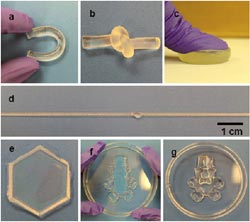University of Akron researchers explore biomedical uses for hydrogels

Agar/PAM DN hydrogels show extraordinary mechanical and free-shapeable properties: (a) bending; (b) knotting; (c) compression; (d) (stretching); (e) hexagon; (f) teddy bear gel under compression; and (g) teddy bear gel after force release.<br>
No, it's not “flubber” — it's a hydrogel, and now scientists at The University of Akron are exploring new biomedical uses for this polymer-based product.
Dr. Jie Zheng, associate professor of chemical and biomolecular engineering, and Dr. Robert Weiss, Hezzleton E. Simmons professor and chair of polymer engineering, are among the most recent to contribute to the growing research of hydrogels, the gelatinous substance that, because of its toughness and plasticity, has several biomedical applications, including cartilage repair, implants for minimally invasive surgery and drug delivery.
Simplifying production process
Since, as Zheng says, “all existing methods to prepare double-network hydrogels involve multiple-step processes, which are tedious and time-consuming,” Zheng and his team developed a simple, efficient and one-pot method (in which reactions occur in one as opposed to several pots) to synthesize double-network hydrogels — that is, hydrogels composed of two networks of polymer chains, one rigid, the other ductile.
Zheng not only made the synthesis of these hydrogels more efficient — he also made the hydrogels tougher.
Most hydrogels are weak and brittle, “suffering from low mechanical strength, poor toughness, and/or limited extensibility and recoverability,” Zheng says.
His hydrogels, however, “exhibit high mechanical properties, excellent recoverable properties, and a unique, free-shapeable property,” he says, making them promising replacements for load-bearing soft tissues like cartilage, tendon, muscle and blood vessels.
Weiss also has synthesized a tougher brand of hydrogel, a “shape memory hydrogel,” which can be bent and stretched and fixed into temporary shapes. When exposed to an external stimulus, such as temperature, light, moisture, or an electric field, shape memory polymers recover their original, permanent shape.
Useful shape-shifters
Weiss's shape memory hydrogels are thermally actuated, meaning they stretch and change shape when heated, and they retain this temporary shape when cooled.
Biocompatible, shape memory hydrogels have the potential to be used for minimally invasive surgery and drug delivery, Weiss says.
“Shape memory may be useful for deployment of hydrogels in biomedical applications using less invasive methods … for example, one can implant a compact form of the device that would deploy into the usable shape after it is implanted,” he says.
For example, a small form of the shape memory hydrogel may be inserted into the body, where, upon absorbing bodily fluids, it expands into the desired shape of the implant, thus filling a wound or replacing tissue.
The permeable hydrogels can also be loaded with drugs and placed into the body, where the sponge-like gel biodegrades and releases the drugs from its pores.
Weiss and co-author Jinkun Hao published their findings, “Mechanically Tough, Thermally Activated Shape Memory Hydrogels,” on Jan. 7, 2013, in ACS Macro Letters.
Zheng's method has received provisional approval for a patent, and his paper, “A Robust, One-Pot Synthesis of Highly Mechanical and Recoverable Double-Network Hydrogels Using Thermo-Reversible Sol-Gel Polysaccharide,” co-authored by Zheng and his UA research colleagues, Qiang Chen, Lin Zhu, Chao Zhao and Qiuming Wang, was published June 14, 2013, online in Advanced Materials.
Story by Nicholas Nussen
Media Contact
More Information:
http://www.ukron.eduAll latest news from the category: Materials Sciences
Materials management deals with the research, development, manufacturing and processing of raw and industrial materials. Key aspects here are biological and medical issues, which play an increasingly important role in this field.
innovations-report offers in-depth articles related to the development and application of materials and the structure and properties of new materials.
Newest articles

Silicon Carbide Innovation Alliance to drive industrial-scale semiconductor work
Known for its ability to withstand extreme environments and high voltages, silicon carbide (SiC) is a semiconducting material made up of silicon and carbon atoms arranged into crystals that is…

New SPECT/CT technique shows impressive biomarker identification
…offers increased access for prostate cancer patients. A novel SPECT/CT acquisition method can accurately detect radiopharmaceutical biodistribution in a convenient manner for prostate cancer patients, opening the door for more…

How 3D printers can give robots a soft touch
Soft skin coverings and touch sensors have emerged as a promising feature for robots that are both safer and more intuitive for human interaction, but they are expensive and difficult…





















